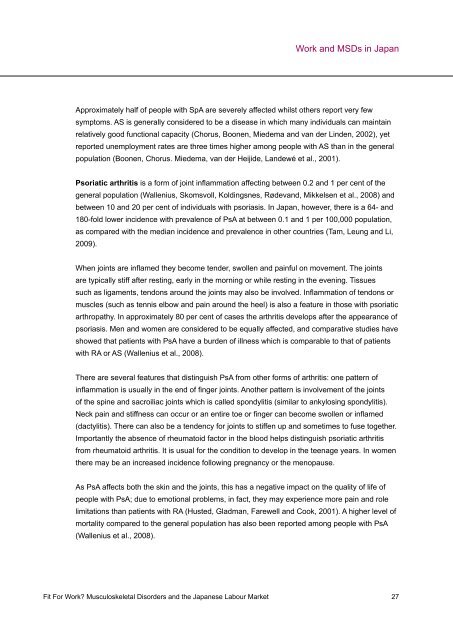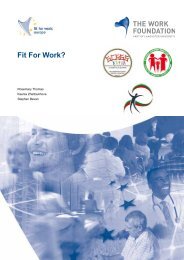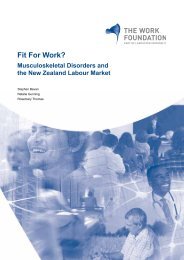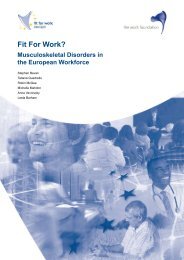English version - Fit for Work Europe
English version - Fit for Work Europe
English version - Fit for Work Europe
Create successful ePaper yourself
Turn your PDF publications into a flip-book with our unique Google optimized e-Paper software.
<strong>Work</strong> and MSDs in Japan<br />
Approximately half of people with SpA are severely affected whilst others report very few<br />
symptoms. AS is generally considered to be a disease in which many individuals can maintain<br />
relatively good functional capacity (Chorus, Boonen, Miedema and van der Linden, 2002), yet<br />
reported unemployment rates are three times higher among people with AS than in the general<br />
population (Boonen, Chorus. Miedema, van der Heijide, Landewé et al., 2001).<br />
Psoriatic arthritis is a <strong>for</strong>m of joint inflammation affecting between 0.2 and 1 per cent of the<br />
general population (Wallenius, Skomsvoll, Koldingsnes, Rødevand, Mikkelsen et al., 2008) and<br />
between 10 and 20 per cent of individuals with psoriasis. In Japan, however, there is a 64- and<br />
180-fold lower incidence with prevalence of PsA at between 0.1 and 1 per 100,000 population,<br />
as compared with the median incidence and prevalence in other countries (Tam, Leung and Li,<br />
2009).<br />
When joints are inflamed they become tender, swollen and painful on movement. The joints<br />
are typically stiff after resting, early in the morning or while resting in the evening. Tissues<br />
such as ligaments, tendons around the joints may also be involved. Inflammation of tendons or<br />
muscles (such as tennis elbow and pain around the heel) is also a feature in those with psoriatic<br />
arthropathy. In approximately 80 per cent of cases the arthritis develops after the appearance of<br />
psoriasis. Men and women are considered to be equally affected, and comparative studies have<br />
showed that patients with PsA have a burden of illness which is comparable to that of patients<br />
with RA or AS (Wallenius et al., 2008).<br />
There are several features that distinguish PsA from other <strong>for</strong>ms of arthritis: one pattern of<br />
inflammation is usually in the end of finger joints. Another pattern is involvement of the joints<br />
of the spine and sacroiliac joints which is called spondylitis (similar to ankylosing spondylitis).<br />
Neck pain and stiffness can occur or an entire toe or finger can become swollen or inflamed<br />
(dactylitis). There can also be a tendency <strong>for</strong> joints to stiffen up and sometimes to fuse together.<br />
Importantly the absence of rheumatoid factor in the blood helps distinguish psoriatic arthritis<br />
from rheumatoid arthritis. It is usual <strong>for</strong> the condition to develop in the teenage years. In women<br />
there may be an increased incidence following pregnancy or the menopause.<br />
As PsA affects both the skin and the joints, this has a negative impact on the quality of life of<br />
people with PsA; due to emotional problems, in fact, they may experience more pain and role<br />
limitations than patients with RA (Husted, Gladman, Farewell and Cook, 2001). A higher level of<br />
mortality compared to the general population has also been reported among people with PsA<br />
(Wallenius et al., 2008).<br />
<strong>Fit</strong> For <strong>Work</strong>? Musculoskeletal Disorders and the Japanese Labour Market 27







